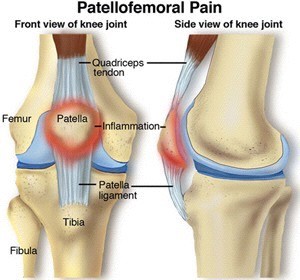Patellofemoral pain syndrome (PFPS) is one of the most common types of knee pain, particularly among athletes, active teenagers, older adults, and people whose jobs require a lot of physical labor. Patellofemoral pain syndrome refers to pain at the front of the knee and in and around the kneecap (patella). The pain is usually accompanied by tenderness along the edges of the patella. Current research indicates that PFPS is an “overuse syndrome,” which means that it may result from repetitive or excessive use of the knee. Other contributing causes may include: muscle weakness, tightness, or stiffness around the knee or an abnormality in the way the lower leg lines up with the hip, knee, and foot. These conditions can interfere with the ability of the patella to glide smoothly on the femur (the bone that connects the knee to the thigh) during movement. The friction between the under-surface of the patella and the femur causes the pain and irritation commonly seen in PFPS. PFPS often occurs in people who are physically active or who have suddenly increased their level of activity, especially when that activity involves repeated knee motion, running, stair climbing, squatting, or repeated carrying of heavy loads. If you are older, you might have age-related changes that cause the cartilage on the under-surface of the patella to wear out. The result is pain and difficulty completing even the simplest daily tasks without pain. Usually, patellofemoral pain is worse when walking up or down hills or stairs and on uneven surfaces. This pain tends to increase with activity and improve with rest. Pain may also increase after sitting for long periods of time with the knee bent.
